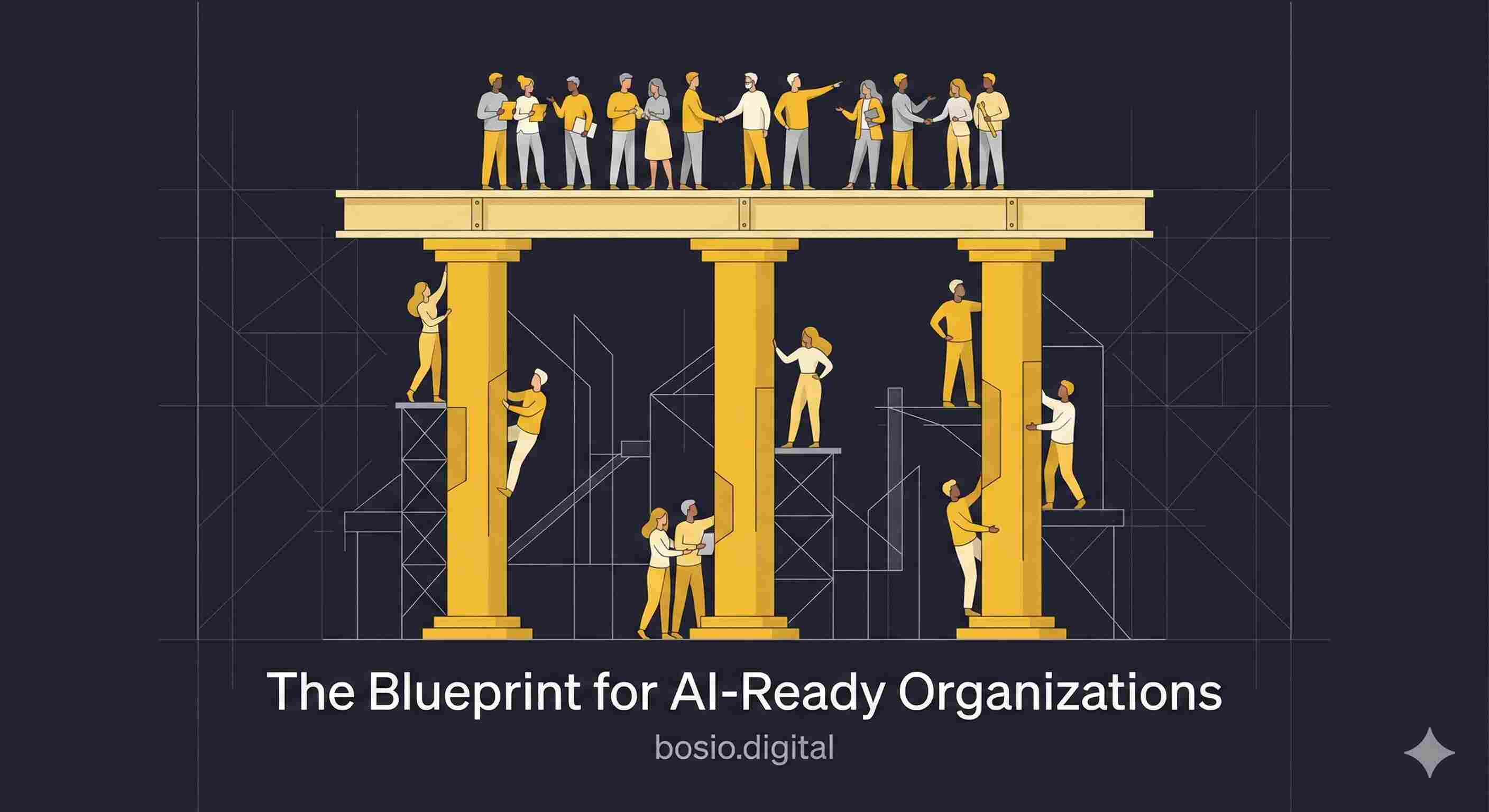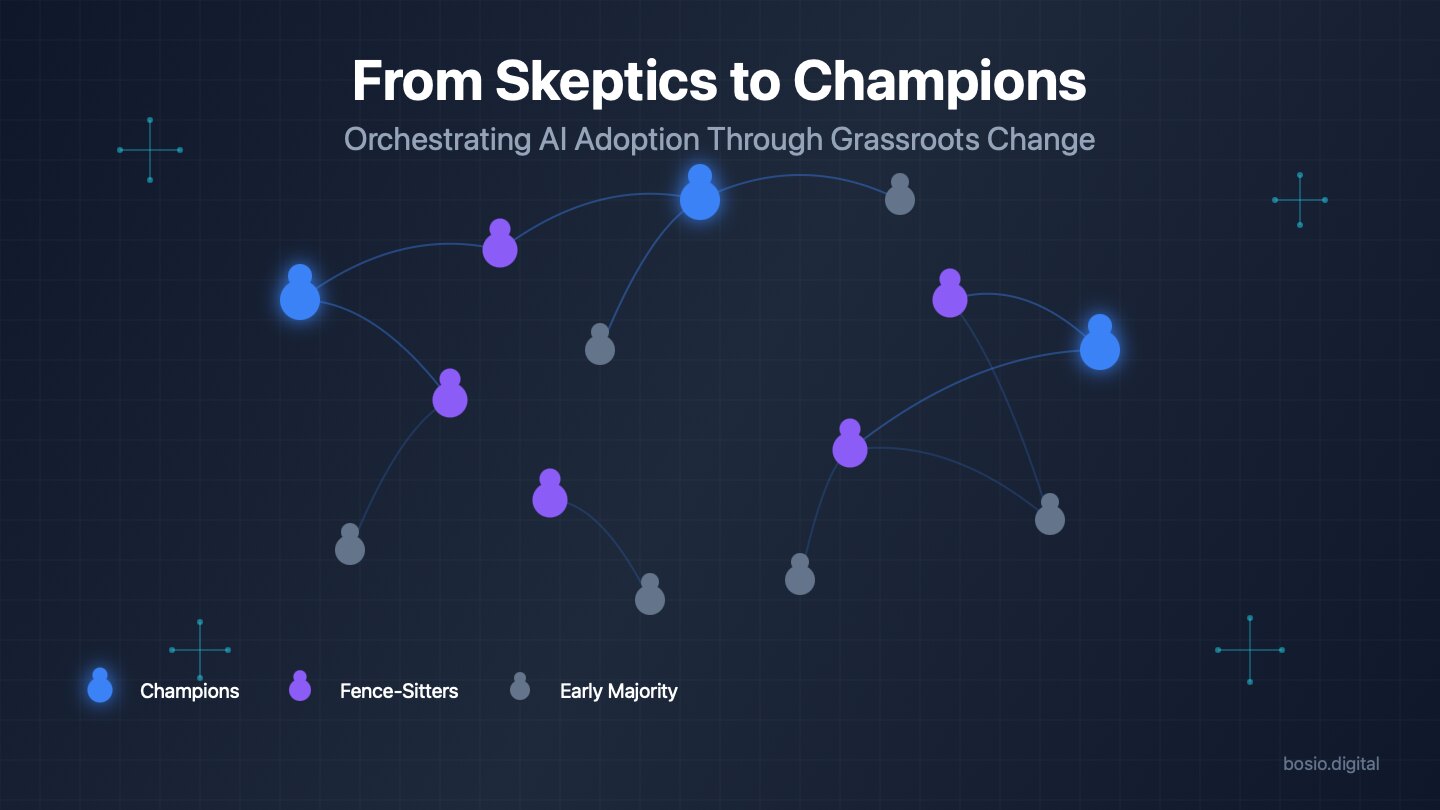
Strategic AI Adoption: A Business Guide
It feels like technology is leaping forward faster than ever, doesn't it? Artificial Intelligence, or AI, seems to be everywhere, fundamentally changing how we work and live. For businesses, AI essentially means using technology to simulate human intelligence for tasks like learning from data, solving problems, or making predictions.
The conversation today isn't really about if AI will reshape the business landscape – that seems almost certain. The real question is how companies should navigate this shift. With the global AI market projected to hit nearly US$244 billion in 2025 and grow at a staggering rate (around 36% annually through 2030 according to some forecasts), ignoring AI isn't much of an option for those looking to stay competitive.
Understanding AI's potential – the good, the challenging, and the practical steps to get started – is crucial for making smart decisions. Exploring the reasons why adoption is compelling, the potential roadblocks, and how to approach implementation thoughtfully can help leaders chart the right course. Making sense of this rapidly evolving technology is the first step toward harnessing its power effectively.
The Compelling Case for AI Adoption: Why Now?
Artificial intelligence isn't just a concept from science fiction anymore; it's rapidly becoming a fundamental part of doing business today. For companies looking to grow and stay relevant, adopting AI is shifting from a 'maybe someday' idea to a 'need it now' reality. Why the urgency? Because AI offers tangible benefits that directly impact competitiveness and the bottom line. From streamlining how work gets done to uncovering new opportunities in data, AI is proving itself as a powerful tool for efficiency, smarter decision-making, better customer connections, and driving innovation. Many business leaders now see AI as fundamental to their strategy, recognizing that failing to integrate it risks falling behind.
Boosting Efficiency and Productivity
One of the most immediate and noticeable impacts of AI is its ability to supercharge efficiency and productivity. Think about all the routine, time-consuming tasks that fill up a workday – things like data entry, scheduling, processing documents, or even answering basic customer questions. AI excels at automating these kinds of repetitive jobs.
When AI takes over these tasks, it does more than just save time. It frees up your team to focus on work that requires human ingenuity – strategic thinking, creative problem-solving, and building relationships. For example, AI can screen resumes, allowing HR professionals to focus on interviewing and assessing candidates. Chatbots can handle common customer inquiries 24/7, letting human agents tackle more complex issues. This automation often leads to increased speed and accuracy, reducing the human errors that can creep into repetitive work and ultimately lowering operational costs. Research suggests AI has the potential to significantly boost employee productivity, in some cases by up to 40%, translating into better resource allocation and a more focused workforce.
Enhancing Decision-Making with Data
In today's world, businesses are swimming in data. The challenge isn't just collecting it, but making sense of it all to make smart choices. This is where AI truly shines. AI systems can analyze massive, complex datasets far faster and often more accurately than humans can, uncovering hidden patterns, trends, and insights that might otherwise be missed.
This capability leads to more informed, data-driven decisions across the board – from marketing and sales strategies to financial planning and operational adjustments. For instance, AI-powered predictive analytics can forecast market shifts or customer demand with impressive accuracy, helping businesses optimize inventory, identify new market opportunities, or allocate resources more effectively. Retailers might use it to minimize stockouts, while financial institutions can leverage it for better risk assessment. Having this deeper level of insight provides a clear strategic advantage, allowing companies to anticipate changes and act proactively rather than reactively.
Improving Customer Experiences
Customers today expect personalized and seamless interactions. AI makes it possible to deliver these kinds of tailored experiences at scale. By analyzing customer data – like purchase history, Browse behavior, and feedback – AI can help businesses understand individual preferences and needs much better.
This understanding allows for highly personalized marketing messages, product recommendations that feel relevant (think of those "you might also like" sections online), and customer support that anticipates needs. AI-powered chatbots and virtual assistants offer instant, 24/7 support for common questions, improving response times and freeing up human agents for more complex interactions. Furthermore, AI can analyze customer feedback from surveys, reviews, or social media to identify areas for improvement in products or services. Delivering these enhanced, personalized experiences is key to building stronger customer relationships, boosting satisfaction, and fostering long-term loyalty.
Driving Innovation and Competitiveness
Beyond optimizing current operations, AI is a powerful engine for innovation and staying ahead of the curve. In a rapidly changing market, the ability to innovate quickly – whether developing new products and services or finding novel ways to improve existing ones – is crucial. AI accelerates this process. It can assist in research and development, help generate new ideas, optimize designs, and even speed up software development.
Adopting AI is increasingly seen not just as an advantage, but as essential for competitiveness. Companies leveraging AI can often respond more effectively to market changes, optimize their strategies faster, and discover new avenues for growth. Early adoption can provide a significant edge, while delaying can mean losing ground to more agile competitors. As AI continues to transform industries from manufacturing and logistics to healthcare and finance, integrating it thoughtfully into business strategy is becoming a key priority for future-proofing and sustained success.
Navigating the Hurdles: Challenges and Risks of AI Adoption
While the potential benefits of AI are exciting, the path to successfully integrating it into your business isn't always smooth. It's important to have a realistic view – AI adoption comes with its own set of challenges and potential risks that companies need to navigate carefully. Many organizations find that implementing AI is more complex than anticipated, and achieving the desired results isn't guaranteed. Understanding these hurdles upfront can help you plan better and increase your chances of success.
Data-Related Challenges
AI systems are incredibly hungry for data, and the quality of that data is paramount. Think of it like cooking – even the best chef can't make a great meal with poor ingredients. Similarly, AI models trained on flawed data will produce flawed results. One major challenge is simply getting enough high-quality data. Many businesses struggle with insufficient data volume, or the data they have is inaccurate, incomplete, or improperly labeled.
Another common issue is data silos. Information often gets trapped in different departments or systems that don't talk to each other, making it difficult to get a complete picture for the AI to analyze. Integrating data from these diverse sources and cleaning it up – a process called data preparation – can be time-consuming and expensive. Furthermore, hidden biases within datasets can lead AI systems to make unfair or discriminatory decisions, amplifying existing societal prejudices. Ensuring data accuracy and fairness is a critical, ongoing task, as poor data quality is a frequent reason why AI projects fail. In fact, 81% of AI professionals report their companies still face significant data quality issues.
Cost and Financial Justification
Bringing AI into your business often requires a significant upfront investment. This isn't just about buying software; it can involve purchasing powerful hardware like servers or investing in cloud infrastructure capable of handling AI's processing demands. There are also costs associated with acquiring or developing AI software and, crucially, hiring specialized talent.
Because of these initial outlays, building a solid business case and justifying the expense can be a major hurdle. Calculating the Return on Investment (ROI) for AI isn't always straightforward, especially beforehand. While the potential long-term gains in efficiency, innovation, and revenue can be substantial – studies suggest generative AI initiatives can yield an average ROI of around 3.7 times the initial investment – proving this value before implementation can be difficult. Companies need to carefully weigh the short-term costs against the potential long-term benefits.
Skills Gap and Talent Acquisition
Even with the right technology and data, AI initiatives need skilled people to drive them. Currently, there's a significant shortage of professionals with the necessary AI expertise, such as data scientists and machine learning engineers. This tech talent shortage makes hiring and retaining these individuals incredibly competitive and often expensive.
Hiring candidates with AI skills is reportedly more challenging than for other tech roles, leading many companies to offer higher salaries. Beyond hiring specialists, there's also the challenge of upskilling the existing workforce. For a detailed framework on assessing team readiness and implementing effective AI training, see our practical guide to AI Team Adoption.. Employees across various departments need to learn how to work effectively alongside new AI systems and understand how to leverage AI tools in their daily tasks. Many employees feel that companies lag in providing adequate AI training, making this human resource challenge a critical barrier to successful AI adoption.
Integration and Infrastructure Complexity
Introducing AI into an existing business environment often involves significant technical hurdles, particularly when dealing with older, legacy IT systems. These older systems might not be compatible with modern AI applications, requiring extensive customization, middleware solutions, or even complete infrastructure overhauls. Integrating AI smoothly can be costly and time-consuming.
Furthermore, AI systems demand robust infrastructure capable of handling intensive data processing and storage. Companies need to assess whether their current setup can support AI's demands or if investments in upgrades, potentially moving to cloud-based solutions, are necessary. Interestingly, while technology presents challenges, studies suggest that implementation failures are often more related to people and process issues than the technology itself.
Ethical Concerns and Responsible AI
Beyond the technical and financial aspects, adopting AI brings important ethical considerations to the forefront. How AI uses data raises privacy concerns, especially when dealing with personal customer or employee information. Ensuring data security and protecting against breaches is critical, as AI systems can be vulnerable targets.
The potential for bias baked into algorithms is a major ethical risk, potentially leading to unfair or discriminatory outcomes in areas like hiring or customer service. Another challenge is the "black box" problem – the difficulty in understanding exactly how some complex AI models arrive at their decisions, which impacts transparency and accountability. Concerns about AI potentially displacing human workers also need to be addressed through clear communication and strategies for workforce adaptation. To navigate these issues, businesses need to establish strong AI governance frameworks, setting clear policies and ethical guidelines to build trust, ensure compliance with regulations, and promote the responsible use of AI.
Charting the Course: Strategic Steps for AI Implementation
Deciding to integrate AI is a significant step, but the journey doesn't end there. Successfully bringing AI into your business requires a thoughtful, strategic plan. It's less about chasing the latest tech trend and more about methodically aligning AI with your core business objectives. Think of it as plotting a course on a map – you need to know where you're going and the key landmarks along the way. This involves defining clear goals, assessing your readiness, building the right team, choosing appropriate tools, managing the human side of change, and ensuring ethical practices from the start. Let's break down these practical steps.
Define Clear Business Goals and Use Cases
Before diving into algorithms or platforms, the first question should always be: "What business problem are we trying to solve, or what opportunity can AI help us seize?" Successful AI adoption starts with clear, measurable business goals – maybe it's boosting efficiency in a specific department, reducing operational costs, enhancing customer satisfaction, or gaining a competitive edge.
Work backward from these desired outcomes. Identify specific, high-impact areas where AI could make a real difference. This could involve automating repetitive tasks, improving forecasting accuracy, personalizing marketing efforts, or uncovering hidden insights in your data. It's tempting to try everything at once, but leading companies often find more success by focusing their resources on fewer, high-priority initiatives that promise significant value and are actually feasible to implement. Prioritize your potential AI use cases based on their strategic importance and how achievable they are given your current resources and capabilities.
Assess Data Readiness and Infrastructure
AI runs on data, so a critical early step is taking an honest look at your current data landscape and the technology supporting it. Is your data accurate, complete, accessible, and well-governed? Often, data is stuck in silos, inconsistent, or not properly prepared for AI analysis. Identifying and addressing these data quality and accessibility issues is fundamental. You'll also need robust data governance policies covering data stewardship, usage, and compliance with regulations like GDPR.
Beyond data, consider your IT infrastructure. AI models, especially complex ones, demand significant computing power (often requiring specialized hardware like GPUs or TPUs), scalable storage solutions, and efficient networking. Evaluate whether your current systems can handle these demands or if upgrades are needed. This might involve investing in on-premises hardware or exploring cloud-based AI platforms, which offer scalability and access to pre-built tools, depending on your specific needs regarding cost, control, and flexibility. Remember, the specific data and infrastructure requirements will depend heavily on the AI use cases you've prioritized.
Build or Acquire Necessary Talent and Skills
Having the right technology isn't enough; you need people with the right skills to leverage it effectively. Addressing the AI skills gap is a common challenge. One approach is to hire specialized talent like data scientists and machine learning engineers, though competition can be fierce. Another strategy is to partner with external AI vendors or consultants who bring specialized expertise.
Perhaps most importantly, focus on developing your internal talent. This involves both upskilling – helping current employees enhance their existing skills to work with AI – and reskilling – training employees in entirely new capabilities for evolving roles. Invest in targeted training programs, potentially using AI itself to create personalized learning paths. Crucially, foster a workplace culture that values continuous learning, experimentation, and data literacy across all departments. Encourage knowledge sharing through mentorship programs or internal communities of practice to build collective AI competency. Providing hands-on opportunities to apply new skills is also key for building confidence and retention.
Choose the Right Tools and Technologies
With clear goals, data readiness assessed, and a talent strategy in place, you can start selecting the specific AI tools and technologies that fit your needs. The options are vast, ranging from machine learning platforms and libraries (like TensorFlow or PyTorch) to natural language processing tools and specialized AI software applications.
The key is to choose tools that align with your defined use cases, integrate well with your existing (or planned) infrastructure, and fit your budget. Don't feel pressured to adopt the most complex solution immediately. It's often wise to start small. Consider launching pilot projects or proofs-of-concept for your prioritized use cases. These smaller-scale trials allow you to test the technology in a controlled environment, gather valuable user feedback, measure initial results against defined metrics, and refine your approach before committing to a large-scale rollout.
Focus on People, Process, and Change Management
Technology is only one piece of the AI puzzle. Research and experience from leading companies suggest a "70-20-10 rule" for successful AI transformation: 70% of the effort should focus on people and process changes, 20% on technology and data infrastructure, and only 10% on the algorithms themselves. This highlights the critical importance of the human element.
Implementing AI often requires changes to existing workflows and job roles, which can naturally cause uncertainty or resistance among employees. Effective change management is therefore essential. This involves clear and consistent communication about the 'why' behind the AI initiatives, involving employees early in the process, and actively addressing concerns, particularly around job security, by framing AI as a tool to augment human capabilities, not replace them. Providing adequate training and support is crucial. Fostering collaboration between technical teams and business units ensures AI solutions truly meet business needs and are integrated smoothly into daily operations.
Implement Governance and Ethical Standards
Finally, as you implement AI, establishing strong governance and ethical guidelines from the outset is non-negotiable. This involves creating a clear AI governance framework that outlines policies, procedures, roles, and responsibilities for how AI is developed, deployed, and monitored within your organization.
This framework should be built on core principles of responsible AI: fairness (mitigating bias), transparency (understanding how decisions are made), accountability (knowing who is responsible), privacy, and security. Implement robust processes for testing AI systems and monitoring them continuously for performance, bias, and compliance with legal and ethical standards. Prioritizing data privacy and security through measures like encryption and access controls is vital. By embedding these ethical considerations into your AI strategy, you build trust with employees, customers, and regulators, ensuring your AI adoption is both effective and responsible.
AI in Action: Real-World Applications Across Business Functions
So, we've talked about the strategy and the steps involved in bringing AI into your business. But what does this actually look like day-to-day? The potential of AI becomes much clearer when we see how it's already being put to work across different departments. It's not just about futuristic concepts anymore; AI is actively helping businesses operate smarter and serve customers better right now. Let's look at some concrete examples across various business functions.
Marketing and Sales
Marketing and sales teams are often at the forefront of AI adoption, using it to understand customers better and reach them more effectively. AI excels at analyzing vast amounts of customer data to personalize marketing campaigns at a scale previously unimaginable. This means tailoring content, product recommendations, and offers to individual preferences based on Browse history, purchase patterns, and demographic information.
AI algorithms can also segment customers into highly specific groups, allowing for more targeted and efficient campaigns. Predictive analytics, powered by AI, helps forecast sales trends with greater accuracy and identify which leads are most likely to convert (lead scoring), allowing sales teams to focus their efforts where they'll have the most impact. Furthermore, generative AI tools are increasingly used to brainstorm marketing ideas, draft email copy, create social media posts, and even generate initial designs for ad creatives, freeing up marketers for more strategic tasks.
Customer Service
Customer service is another area where AI has made significant inroads, primarily focused on improving efficiency and responsiveness. AI-powered chatbots and virtual assistants are perhaps the most common example, handling a large volume of routine customer inquiries 24/7. They can answer frequently asked questions, track orders, process returns, and guide users through simple troubleshooting steps instantly, reducing wait times.
Beyond chatbots, AI analyzes customer interactions (calls, emails, chat logs) to gauge sentiment, helping businesses understand customer satisfaction levels and identify areas for improvement. This data can also personalize support interactions when a human agent does get involved. AI systems can intelligently route complex issues to the most appropriate human agent based on the query's intent and the agent's skills. They can even assist agents by summarizing long conversation histories or suggesting relevant knowledge base articles in real-time. The high adoption rate here reflects AI's ability to both cut costs and enhance the customer experience.
Operations and Supply Chain
In the realm of operations and supply chain management, AI is driving significant efficiency gains. Process automation is a major application, where AI handles repetitive tasks within workflows, reducing manual effort and errors. For physical operations, predictive maintenance is a key use case; AI analyzes sensor data from machinery to predict potential failures before they happen, allowing for proactive maintenance and minimizing costly downtime.
AI optimizes complex supply chains by improving demand forecasting, analyzing historical data, market trends, and even external factors like weather to predict needs more accurately. This leads to better inventory management, reducing both overstocking and stockouts. AI algorithms also optimize logistics, finding the most efficient transportation routes by considering real-time traffic, fuel costs, and delivery schedules. In manufacturing, AI-powered visual inspection systems can automate quality control, identifying defects with greater speed and consistency than human inspectors.
Finance and Risk Management
The finance sector leverages AI primarily for its analytical power in managing risk and automating processes. Fraud detection is a critical application, where AI algorithms analyze transaction patterns in real-time to identify suspicious activities far faster and more accurately than traditional methods, helping prevent financial crime. Similarly, AI enhances risk assessment by analyzing vast datasets to model credit risk, predict market fluctuations, or assess potential investment risks.
AI also automates many routine financial tasks, such as generating financial reports, processing invoices, and managing expenses, increasing accuracy and freeing up finance professionals for more strategic analysis. In some areas, algorithmic trading uses AI to execute trades at high speeds based on market data analysis. AI tools can also help ensure regulatory compliance by monitoring transactions and generating necessary reports.
Human Resources (HR)
Even in a function centered on people, AI is proving to be a valuable tool for HR departments. One of the most common uses is streamlining recruitment. AI can screen resumes and applications, quickly identifying candidates whose skills and experience match job requirements, saving recruiters significant time. AI-powered chatbots can handle initial candidate interactions, answer common questions about benefits or policies, and even assist with scheduling interviews.
Beyond hiring, AI helps personalize the employee experience. It can assist in automating parts of the onboarding process, making it smoother for new hires. AI tools can analyze employee feedback from surveys or performance reviews to identify trends in engagement or areas needing improvement. They can also help tailor learning and development programs to individual employee needs and career goals, and even assist in workforce planning by predicting future staffing requirements based on historical data and business forecasts.
Product Development and IT
In product development and IT, AI acts as a powerful assistant, accelerating innovation and improving efficiency. For software development teams, AI tools can assist in generating code snippets, debugging existing code, and automating software testing processes, significantly speeding up development cycles. AI analyzes user data and market trends to provide valuable insights that inform product design and feature prioritization, helping teams build products that better meet customer needs.
AI can also accelerate the design process itself, generating design variations or creating prototypes based on specified parameters. In IT operations (often called AIOps), AI helps monitor system performance, predict potential issues, analyze system logs to identify errors, and automate routine maintenance tasks, ensuring smoother and more reliable IT infrastructure. This allows development and IT teams to focus more on innovation and strategic initiatives.
Frequently Asked Questions (FAQs)
What exactly is AI in a business context?
In a business context, Artificial Intelligence (AI) refers to computer systems designed to perform tasks that typically require human intelligence. This includes capabilities like learning from data, solving problems, making decisions, understanding language, and recognizing patterns to optimize various business functions and improve efficiency.
Is AI adoption too expensive for small businesses?
While initial AI investments can seem costly, the landscape is changing. Many affordable, scalable AI tools and cloud-based services are now available, making AI more accessible for small businesses. It's often recommended to start with specific, high-impact projects to demonstrate return on investment (ROI) before scaling up.
Will AI replace human jobs?
AI is more likely to transform jobs rather than eliminate them entirely. While AI automates certain tasks, particularly repetitive ones, it also creates new roles focused on developing, managing, and working alongside AI systems. This shift emphasizes the need for workforce adaptation, reskilling, and focusing on uniquely human skills like creativity, critical thinking, and emotional intelligence.
What are the biggest risks of implementing AI?
The main risks associated with implementing AI include ensuring data quality and mitigating bias in algorithms, justifying the cost and proving return on investment, addressing the shortage of skilled AI talent, managing the complexity of integrating AI with existing systems, and navigating ethical concerns like data privacy, security, and algorithmic transparency.
How can my company start with AI if we have limited resources?
Companies with limited resources can start by clearly defining specific business problems AI can solve and focusing on high-impact, feasible use cases. Explore affordable cloud-based AI services and readily available AI tools, prioritize getting your data ready, and consider partnering with specialized vendors. Starting small with pilot projects is often a good approach.
What is Generative AI (like ChatGPT) and how can businesses use it?
Generative AI refers to AI models capable of creating new, original content, such as text, images, code, or audio, based on the data they were trained on. Businesses use Generative AI for various tasks, including drafting marketing copy and emails, brainstorming ideas, generating code snippets, creating images, summarizing documents, and powering more sophisticated customer service chatbots.
Conclusion
Artificial intelligence is clearly shifting from a future possibility to a present-day strategic necessity. Embracing it can unlock significant advantages, from streamlining operations and boosting productivity to making smarter, data-backed decisions and creating truly personalized customer experiences. These benefits are increasingly vital for staying competitive and driving growth.
Of course, the path isn't without obstacles. Concerns around costs, data quality, ethical implications, and finding the right skills are real challenges that businesses face. However, these hurdles can be navigated with careful planning, a focus on people and processes, and a commitment to responsible implementation.
Ultimately, thoughtful, strategic AI adoption is becoming essential for future success. It's time for leaders to view AI not just as another tool, but as a potential partner in transformation, acting decisively yet mindfully to harness its power effectively.
















